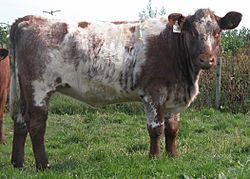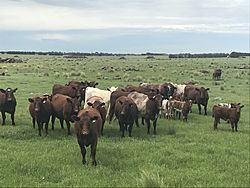Interesting Facts About Shorthorn Beef Cattle

A red shorthorn bull

A roan shorthorn heifer
The Shorthorn breed of cattle originated in the North E of England in the late eighteenth century. The breed was developed as dual-purpose, suitable for both dairy and beefiness product; however, sure blood lines within the brood always emphasised one quality or the other. Over time, these dissimilar lines diverged, and past the 2nd half of the twentieth century, two carve up breeds had developed – the Beef Shorthorn, and the Milking Shorthorn. All Shorthorn cattle are coloured cherry, white, or roan, although roan cattle are preferred by some, and completely white animals are not mutual. However, i type of Shorthorn has been bred to be consistently white – the Whitebred Shorthorn, which was developed to cantankerous with black Galloway cattle to produce a popular bluish roan crossbreed, the Blueish Grey.
Contents
- History
- Distribution
- Australia
- Breed associations
History
The breed developed from Teeswater and Durham cattle found originally in the North Eastward of England. In the late eighteenth century, the Colling brothers, Charles and Robert, started to improve the Durham cattle using the selective breeding techniques that Robert Bakewell had used successfully on Longhorn cattle. In 1796, Charles Colling of Ketton Hall, bred the famous Durham Ox. The culmination of this breeding program was the birth of the bull Comet, bred by Charles Colling, in 1804. This bull was afterward sold for 1000 guineas in 1810 at the Brafferton sale, the get-go g-guinea bull ever recorded. Related cattle may have been imported to the United States by Harry Dorsey Gough of Baltimore, Maryland, before 1808.
At the same time, Thomas Bates of Kirklevington and John Booth of Killesby were developing the Teeswater cattle. The Bates cattle were afterward developed for their milking qualities, whereas the Booth cattle were developed for their beef qualities. Animals taken to Scotland in 1817 from the Booth herd were used to produce the Beef Shorthorn brood.
In 1822, George Coates published the commencement volume of his herd book; this was the first pedigree herd book for cattle in the world.
Coates published the beginning four volumes, after which Henry Stafford took over the ownership and publishing of the herd book, retaining the proper noun Coates's Herd Book. The Shorthorn Society of Great Britain and Ireland was founded in 1874, and purchased the copyright of the herd book from Stafford. They have connected to compile and publish Coates's Herd Book ever since. The American Shorthorn Herd Volume was the outset to be published in the The states for whatsoever breed and was started in 1846, with the formation of the American Shorthorn Association following 26 years later in 1872.
Tibial hemimelia, a rare genetic disorder, was identified in Canada in 1999 in a modest number of Shorthorn cattle, all descended from a single individual.
Distribution

Shorthorn bull, cows & calves
Today, the breed is institute mainly in English-speaking countries, and Southern South America. The main countries are: Argentine republic, Australia, Canada, New Zealand, Ireland, Due south Africa, United Kingdom, the U.s.a. of America, Uruguay, and Zimbabwe. Beamish Museum in due north-eastern England preserves the Durham breed.
Commonwealth of australia
Shorthorn cattle were i of the outset purebred breeds to be imported into Australia when several cows were brought into New South Wales in 1800. More purebred Shorthorns were imported into NSW in 1825 by Potter McQueen of Scone. Nine months later, the Australian Agricultural Company imported additional Shorthorns, and in the 1930s, Thomas Simpson Hall, the breeder of the Halls Heeler, imported Durham Shorthorns from which he developed extensive herds of Poll Shorthorns.
The brood has a wide genetic base, resulting in the evolution of several distinct though closely related strains – these are the traditional strains:
- Beef Shorthorn
- Poll Shorthorn
- Durham
- Milking or Dairy Shorthorn
- Australian Shorthorn
The current Shorthorn Society of Australia encompasses the Poll Shorthorn, Australian Shorthorn, and Durham.
Shorthorns have contributed to the development of breeds such as the Belmont Red and Santa Gertrudis.
Breed associations
All content from Kiddle encyclopedia articles (including the article images and facts) can exist freely used under Attribution-ShareAlike license, unless stated otherwise. Cite this article:
Shorthorn Facts for Kids. Kiddle Encyclopedia.
Source: https://kids.kiddle.co/Shorthorn
0 Response to "Interesting Facts About Shorthorn Beef Cattle"
Postar um comentário